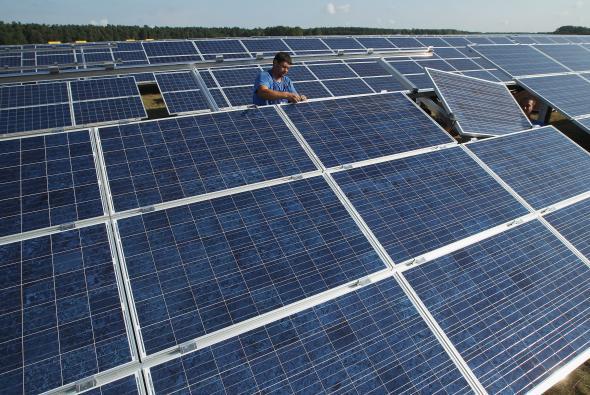When I imagine a sophisticated new technology to improve the efficiency of solar panels, the discovery announced Tuesday at a meeting of the American Chemical Society is not what I’d expect. Instead of some whizz-bang nanotechnology, this new bit of solar tech is a clear, unassuming gel. And instead of rare, precious materials, it’s made out of a cow blood protein that’s one of the biggest waste products in the meat industry.
But mix this gelatinous meat byproduct with the right sort of nontoxic dyes, and it might just be the sort of thing we need to solve a pressing problem: How can we make solar panels gobble up more energy from sunlight without using rare or toxic metals, like cadmium?
Solar is our must abundant energy resource: In one hour, sunlight strikes Earth with more energy than we use worldwide in one year. But silicon photovoltaic solar cells—the most common type of solar cell that converts the photons in sunlight into electricity—can’t take advantage of all this sunlight. Only photons with the right amount of energy get absorbed by PV cells; photons with too little are poorly absorbed, and those with too much waste energy.
To figure out how to convert these wasted photons into usable ones, chemistry professor Challa Kumar of the University of Connecticut took his inspiration from what he calls “edible solar cells”—plants. Kumar and his colleagues, graduate student Jingwen Ding and assistant professor Jie He, knew they wanted to make their solar booster out of materials as biodegradable as plants, instead of silicon and expensive rare-earth elements. The chemists also wanted to use “artificial photosynthesis”—a solar technology that uses a matrix of titanium dioxide nanoparticles and various dyes to harvest sunlight, much like plant chlorophyll. They just needed to figure out a different, biodegradable matrix.
The solution was something that they had been working with for almost 20 years: cow blood protein, aka bovine serum albumin. When the team mixed this cheap, abundant protein with lipids and dyes, the protein created just the right matrix for artificial photosynthesis to work.
Their lab tests were encouraging. When this gel was placed in front of regular PV cells, Kumar says that it “can enhance [absorption of] the red light by a factor of two to four.” Even if this only increases a solar cell’s efficiency by a few percentage points, he says that makes a huge difference in a solar array, which can consist of many solar panels, each with scores of solar cells. Kumar envisions the gel being placed over the standard silicon cell, and then sealed off from rain with a glass or polymer coating. This simple design change means that the gel could perhaps be incorporated more easily into existing manufacturing techniques.
Given these advantages—cheapness, biodegradability, and scalability—Kumar’s team is working with a Connecticut company to evaluate their discovery for commercialization. Nonetheless, he cautions that it could be “five to 10 years of work” overcoming certain challenges, before the gel would be ready for the market.
One potential challenge is artificial photosynthesis itself. Scientists were very optimistic when the technology was first developed in the 1990s, says assistant professor Amanda Morris of Virginia Tech, an expert in solar cell chemistry. For one thing, making cells with artificial photosynthesis was cheaper than making them with silicon. But today, the maximum efficiency of solar cells using artificial photosynthesis has stalled at 13 percent, compared with silicon’s 25 percent efficiency. “There’s this intricate balance between cost and efficiency,” says Morris. In other words, it’s not enough for the team’s new gel technology to be cheap—it has to be efficient, too.
Another major challenge is the gel’s biodegradability. While using biodegradable materials is great for the environment and limits our reliance on rare-earth elements imported from China, it might not be so wonderful for homeowners. “If it’s biodegradable, and you’re putting it on your roof, it’s going to biodegrade,” says Morris. Current silicon solar cells can last 25 years, and it takes up to four years for rooftop solar cells to pay back the energy cost of their manufacture. Furthermore, “it can anywhere from seven to 14 years to pay yourself back” for your upfront purchase of the panels, says Morris. This new gel will need to be tough enough to last multiple years, rather than rotting before it’s earned back its cost. It’s too early to know how long the gel will last, though, because Kumar’s team is just starting to test the gel’s stability.
Despite these challenges, I hope that Kumar and his team—along with other talented chemists—can figure out how to boost solar cell efficiency. Given our pressing need to get off fossil fuels for environmental, climate change, and geopolitical reasons, I’ll personally welcome any advances. But I’d really like it if the solution involves something as unlikely as a gelatinous meat byproduct, if only so we can have what I’d like to call “the spam cell.”
